1. Korea Ministry of Education. Status of School Meals in 2021. Sejong: Ministry of Education;2022.
2. Kim HY. A Study on the Reduction of Sodium in School Meals (report). Sejong: Ministry of Education;2013.
3. Jeon MS. Relevance of snacking at school store, school meal caloric intake and its satisfaction of female middle and high school students [master’s thesis]. Seoul: Yonsei University;2016.
4. Lim H, Ko YS, Shin D, Heo Y, Chung H, Chae I, Kim HY, Kim M, Leem D, Lee Y. Sodium and potassium content of school meals for elementary and junior high school students in Daegu, Masan, Gwangju, and Jeju. J Korean Soc Food Sci Nutr. 2013; 42:1303–1317.

5. Park S, Lee K. Study on the salt and sodium content of middle school lunch meals in Gyeongsangbuk-do area: focus on application of ‘SamSam foodservice’. J Korean Soc Food Sci Nutr. 2016; 45:757–776.
6. Lee S, Chang E, Choi J, Bahn K, Kim M. Current assessment of sodium and potassium intakes in elementary and middle school students through school meals. Korean J Food Sci Technol. 2010; 42:578–585.
7. Lee EM, Park YG, Jung WY, Kim MR, Seo EC, Jung RS, Na MA, Lee JH, Heo OS. Survey on sodium and potassium content of school meals as well as sodium and potassium intake by students in the Daejeon and Chungcheong area. J East Asian Soc Diet Life. 2010; 20:853–862.
8. Meneton P, Jeunemaitre X, de Wardener HE, MacGregor GA. Links between dietary salt intake, renal salt handling, blood pressure, and cardiovascular diseases. Physiol Rev. 2005; 85:679–715. PMID:
15788708.

9. Kurosawa M, Kikuchi S, Xu J, Inaba Y. Highly salted food and mountain herbs elevate the risk for stomach cancer death in a rural area of Japan. J Gastroenterol Hepatol. 2006; 21:1681–1686. PMID:
16984589.

10. Kurtz TW, Al-Bander HA, Morris RC Jr. “Salt-sensitive” essential hypertension in men. Is the sodium ion alone important? N Engl J Med. 1987; 317:1043–1048. PMID:
3309653.
11. Jones G, Beard T, Parameswaran V, Greenaway T, von Witt R. A population-based study of the relationship between salt intake, bone resorption and bone mass. Eur J Clin Nutr. 1997; 51:561–565. PMID:
11248883.

12. Teucher B, Dainty JR, Spinks CA, Majsak-Newman G, Berry DJ, Hoogewerff JA, Foxall RJ, Jakobsen J, Cashman KD, Flynn A, et al. Sodium and bone health: impact of moderately high and low salt intakes on calcium metabolism in postmenopausal women. J Bone Miner Res. 2008; 23:1477–1485. PMID:
18410231.

13. Yoon JS, Lee MJ. Calcium status and bone mineral density by the level of sodium intake in young women. Korean J Community Nutr. 2013; 18:125–133.

14. Pitynski D, Flynn FW, Skinner DC. Does salt have a permissive role in the induction of puberty? Med Hypotheses. 2015; 85:463–467. PMID:
26190310.

15. Korea Ministry of Government Legislation. Enforcement Rule of the School Meals Act, Chapter 5 Article 1. Nutritional Standards for School Meals, etc. Sejong: Korean Law Information Center;2022.
16. Seoul Metropolitan Office of Education. Basic Direction of School Meals in 2022 (Report). Seoul: Seoul Metropolitan Office of Education;2022.
17. Ha IH, Lyu ES. Awareness, practice, and obstruction of sodium reduction by middle school dietitians in Busan area. Korean J Food Cookery Sci. 2015; 31:225–232.

18. Lee KS. Use of salimeters and sodium reduction education in school foodservice in the Gyeonggi area. J Korean Diet Assoc. 2013; 19:173–181.

19. Kim SH, Shin EK, Lee YK. Sodium reduction practice and importance-performance analysis of sodium reduction methods in school foodservice in Daegu. Korean J Community Nutr. 2020; 25:386–395.

20. Lee KS. Study on the perception of school dietitians about sodium and the analysis on sodium reduction using NEIS [master’s thesis]. Suwon: Kyonggi University;2007.
21. Lee JH. Awareness and practice of sodium reduction by elementary, middle and high school dietitians in Gyeonggi area. J East Asian Soc Diet Life. 2012; 22:734–743.
22. Ahn SH, Kwon JS, Kim K, Lee Y, Kim HK. Current status, perception and practicability of restaurant staffs related to reducing sodium use in Seongnam, Korea. J Nutr Health. 2019; 52:475–487.

23. Matzler K, Sauerwein E, Heischmidt K. Importance-performance analysis revisited: the role of the factor structure of customer satisfaction. Serv Ind J. 2003; 23:112–129.

24. Sampson SE, Showalter MJ. The performance-importance response function: observations and implications. Serv Ind J. 1999; 19:1–25.

25. Martilla JA, James JC. Importance-performance analysis. J Mark. 1977; 41:77–79.

26. Park HR, Cha JA, Lim YS. Performance and importance analysis of dietitian’s task in public health nutrition areas. Korean J Community Nutr. 2008; 13:540–554.
27. Park HR, Kim HM, Lee Y, Jeong SY, Lim YS. Sanitation management of cooks in childcare centers in South Korea according to working duration and the type of childcare center: importance-performance analysis. Food Control. 2017; 73:1452–1458.

28. Lee MJ. Survey on the current state of sodium reduction according to dietary behavior and nutrition knowledge of school dietitian [master’s thesis]. Changwon: Kyungnam University;2015.
29. Feldman C, Briceno-Pinar EA, Konas DW, Ruskin M, Toney J, Wunderlich S. A laboratory analysis of total fat content and an examination of portion size of foods served in four New Jersey public middle-school foodservice operations. J Foodserv. 2009; 20:264–274.

30. Diliberti N, Bordi PL, Conklin MT, Roe LS, Rolls BJ. Increased portion size leads to increased energy intake in a restaurant meal. Obes Res. 2004; 12:562–568. PMID:
15044675.

31. Levitsky DA, Youn T. The more food young adults are served, the more they overeat. J Nutr. 2004; 134:2546–2549. PMID:
15465745.

32. Hong SM, Lee JH, Kim HK, Yu R, Seo JH, Huh EJ, Cho SS, Yang J. Study on sodium reduction: ‘Healthy restaurant for sodium reduction’. J Korean Diet Assoc. 2014; 20:174–182.

33. Han JK, Kim H. Comparative study of the job satisfaction, job performance and job importance level of school nutrition teachers and school dietitians. Korean J Food Cult. 2009; 24:525–532.
34. Manios Y, Kafatos A. Health and nutrition education in elementary schools: changes in health knowledge, nutrient intakes and physical activity over a six year period. Public Health Nutr. 1999; 2:445–448. PMID:
10610086.

35. Powers AR, Struempler BJ, Guarino A, Parmer SM. Effects of a nutrition education program on the dietary behavior and nutrition knowledge of second-grade and third-grade students. J Sch Health. 2005; 75:129–133. PMID:
15987006.

36. Wagner N, Meusel D, Kirch W. Nutrition education for children – results and perspectives. J Public Health. 2005; 13:102–110.

37. McAleese JD, Rankin LL. Garden-based nutrition education affects fruit and vegetable consumption in sixth-grade adolescents. J Am Diet Assoc. 2007; 107:662–665. PMID:
17383272.

38. Lytle LA, Stone EJ, Nichaman MZ, Perry CL, Montgomery DH, Nicklas TA, Zive MM, Mitchell P, Dwyer JT, Ebzery MK, et al. Changes in nutrient intakes of elementary school children following a school-based intervention: results from the CATCH study. Prev Med. 1996; 25:465–477. PMID:
8818069.

39. Reynolds K, Winton A, Shewchuk R, Hickey C. Social cognitive model of fruit and vegetable consumption in elementary school children. J Nutr Educ. 1999; 31:23–30.

40. Worsley A. Nutrition knowledge and food consumption: can nutrition knowledge change food behaviour? Asia Pac J Clin Nutr. 2002; 11(Suppl 3):S579–S585. PMID:
12492651.

41. Kim EK, Kim HY. School dietitian awareness, practice, and sodium reduction plan in school meal service. Korean J Food Cookery Sci. 2016; 32:222–232.

42. Mattes RD, Donnelly D. Relative contributions of dietary sodium sources. J Am Coll Nutr. 1991; 10:383–393. PMID:
1910064.

43. Lee MK. Sodium intake of students and sodium content of processed foods used in the school meal service [master’s thesis]. Iksan: Wonkwang University;2009.
44. Korea Ministry of Government Legislation. School Meals Act, Chapter 2 Article 7. Placement, etc. of Nutrition Teachers. Sejong: Korean Law Information Center;2022.
45. Han JI. The work performance and the factor contributing to the work performance of nutrition teacher & school dieticians. J Nutr Health. 2015; 48:558–570.

46. Hong YS, Lee JH. Current status and strategic plan of nutrition education comparing nutrition teachers with dietitians in schools, Gyeonggi area. Korean J Community Nutr. 2013; 18:233–242.

47. Oh H. Revisiting importance–performance analysis. Tour Manage. 2001; 22:617–627.

48. Ko Y, Lee Y, Kim D, Kim H. Analysis of recognition and educational needs on competency of secondary school informatics teachers. Int J Adv Sci Eng Inf Technol. 2017; 7:1632–1637.

49. Son EJ, Yong L, Huh MK. A needs analysis of character education on socio-biological human exploration using Borich priority and locus for focus model. Int J Acad Res Reflect. 2019; 7:16–22.
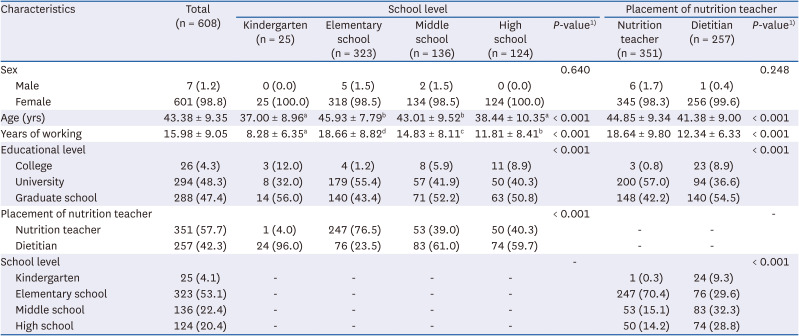
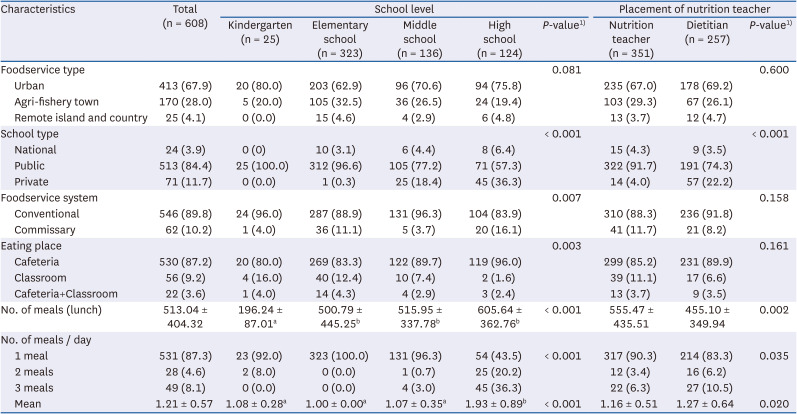
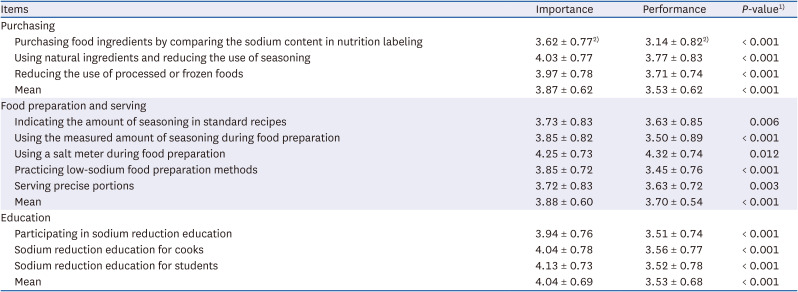
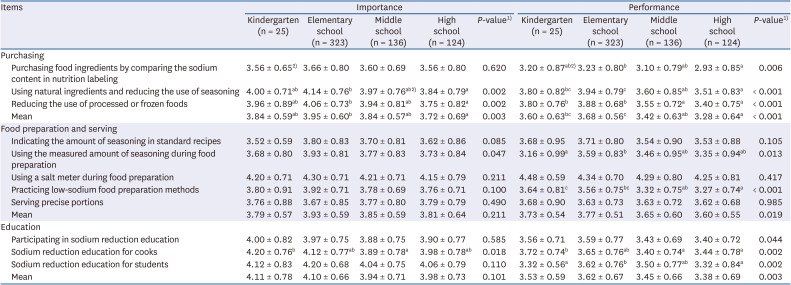





 PDF
PDF Citation
Citation Print
Print



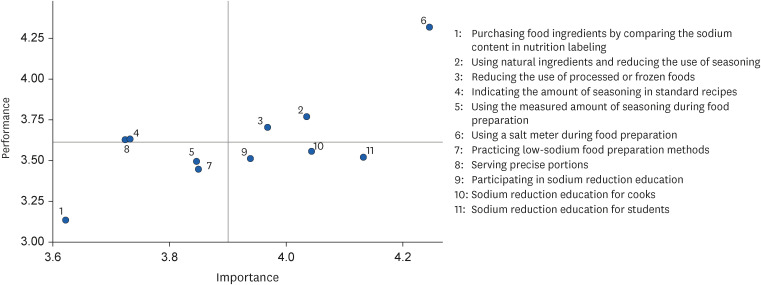
 XML Download
XML Download